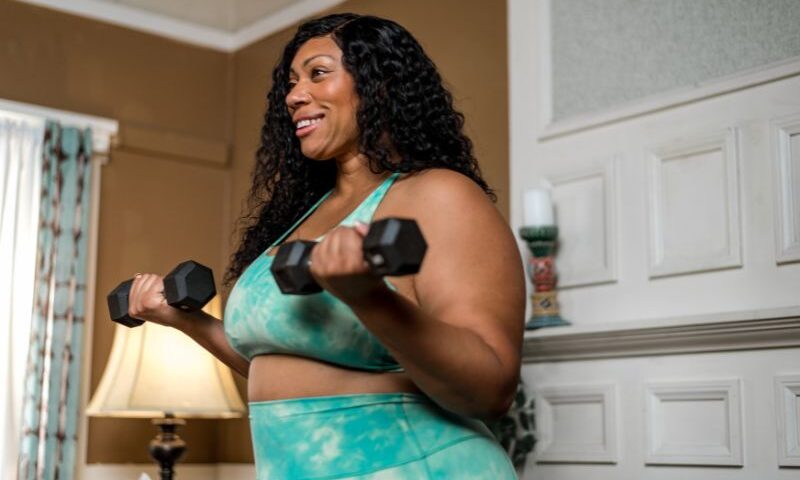Image Source: Stop Weight Bias Image Gallery
When people think about weight loss, cardio exercises like running, cycling or walking are often the first to come to mind. While these activities are effective for burning calories, strength training is an equally important component of a balanced weight-loss and health program.
Strength training, which involves exercises that improve muscle strength and endurance, has numerous benefits beyond just muscle building. It aids in weight management, supports bone health, improves functional fitness and helps preserve muscle mass during weight loss. Here’s why strength training matters, along with some simple exercises to help you get started.
Why Strength Training is Essential for Weight Loss and Health
Increases Metabolism
Strength training helps boost your metabolism, which is crucial for weight management. When you build muscle, your body requires more energy (calories) to maintain it. This increase in muscle mass leads to a higher resting metabolic rate, meaning you burn more calories even when you’re not exercising. Essentially, the more muscle you have, the more calories your body burns throughout the day, aiding in weight loss.
Supports Bone Health
Weight-bearing exercises, including strength training, help strengthen bones and reduce the risk of osteoporosis. As you lift weights, your bones adapt by increasing in density, which is particularly important as we age and natural bone density decreases.
Improves Mental Health
Regular resistance exercise can reduce symptoms of anxiety and depression, increase self-esteem and enhance mood. The mental benefits, combined with the physical improvements, make strength training an invaluable part of a holistic health and wellness routine.
Simple Strength Training Exercises for Beginners
If you’re new to strength training, start with bodyweight exercises, which use your own body weight as resistance. These exercises are effective, require no equipment, and can be done at home or at the gym. Here are a few beginner-friendly strength exercises to get you started:
1. Chair Squats
Instead of traditional squats, use a sturdy chair to help guide your movement.
- How to Do it: Stand in front of the chair with your feet hip-width apart. Slowly lower yourself down until you’re just above the seat of the chair, as if you’re about to sit. Engage your glutes and thighs to stand back up.
- Benefits: Chair squats strengthen the lower body and core while providing stability and reducing pressure on the knees and lower back.
2. Wall Push-Ups
Wall push-ups offer an easier, low-impact way to strengthen the upper body without the strain of a traditional push-up.
- How to Do it: Stand facing a wall and place your hands on the wall at shoulder height, shoulder-width apart. Step back slightly so your body is at an angle. Bend your elbows to bring your chest closer to the wall, then push back to straighten your arms.
- Benefits: Wall push-ups engage the chest, shoulders and triceps while being gentle on the wrists, elbows and core.
3. Supported Lunges
Using a chair or wall for balance can help make lunges more accessible by reducing pressure on the knees and ankles.
- How to Do it: Stand next to a chair or wall for support. Step one foot forward, keeping the back leg in place. Lower your body slightly, focusing on a small range of motion rather than a deep lunge, and press back up. Switch legs and repeat.
- Benefits: This modified lunge targets the legs, glutes and core while allowing for additional support, making it easier to balance.
4. Modified Plank (Against a Wall or Table)
Instead of doing a full plank on the floor, try a standing plank against a sturdy surface like a wall or table. This reduces the load on your core and back.
- How to Do it: Place your hands on a wall or the edge of a sturdy table at shoulder height. Step back until your body forms a straight line from head to heels. Engage your core and hold the position for 10–20 seconds, building up over time.
- Benefits: A modified plank strengthens the core, shoulders, and back, with less strain on the lower back and wrists.
Tips for Getting Started
- Focus on Form: Prioritize good form over speed. Moving slowly and focusing on engaging the correct muscles will give you the best results and reduce the risk of injury.
- Use Support as Needed: Chairs, walls, and stable surfaces can make a big difference in providing stability and reducing joint strain.
- Start Slow: Aim to complete 1–2 sets of each exercise with 8–10 repetitions, gradually increasing as you feel comfortable.
These modified exercises are gentle on the joints and accessible for beginners, especially if you’re starting your fitness journey. Remember, consistency is key, and even small steps can lead to big improvements over time.






